
A History of and Guide to
UNIFORM EDITIONS OF MARK TWAIN'S WORKS
"All night I have been thinking out the details of
my Uniform Edition ..."
- letter to Henry H. Rogers, 3 January 1895
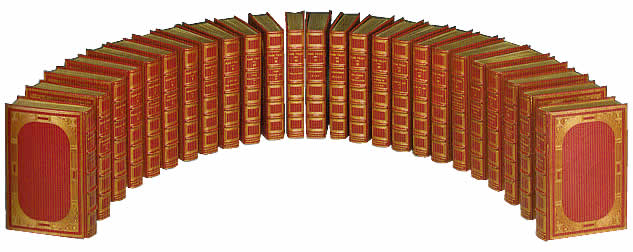
_____
Chapter 1
Early Attempts at Uniformity
Definition of a Uniform Edition
A uniform edition is a collected edition of an author's works
which are bound in identical bindings of uniform size, shape and color meant
to be displayed prominently in a home. They are a visual statement that an
author has reached the upper limits of a stellar career. Uniform editions
also promise additional royalties for an author. For the book buyer, owning
a uniform edition of an author's works signifies both good taste and a lifestyle
that values a home decorated with well-stocked bookshelves. For the book buyer
of the Victorian era, this often meant sets of books bound in red leather
with elaborate gold stamping on the spines and gilt-edged pages. Such uniform
editions appealed to the psychological desire for wholeness and completeness
among both buyers and authors.
A Rival Achieves the Distinction First
Ernest Hemingway, in Green Hills of Africa, wrote, "All
modern American literature comes from one book by Mark Twain called Huckleberry
Finn. American writing comes from that. There is nothing before. There
has been nothing as good since." Clemens was about fifty years old when
Huckleberry Finn was published and very few American authors had written
enough books to justify the production of a uniform edition of their work.
Uniform editions found in most American homes by the middle of the 19th century
were those of British or European authors such as Sir Walter Scott or Charles
Dickens. In 1873, Sam Clemens and his wife Livy purchased a set of Scott's
novels and Clemens proudly wrote to his mother-in-law, "Our books have
come -- a rare thing we have been on the track of for ten days -- got it at
last -- the famous “Abbotsford Edition” of Scott’s works --
12 huge volumes elaborately illustrated" (Samuel
Clemens to Olivia Langdon, 2 and 6 August 1873).
Clemens's former friend and later bitter rival, Bret Harte was
one of the first American authors to have his works published in a uniform
edition in the United States. In a February 5, 1882 item in Clemens's hometown
newspaper, the Hartford Daily Courant, a correspondent wrote
We can hardly be too much obliged to Houghton, Mifflin and Co. for giving
us a complete and uniform edition of the works of Bret Harte. This was just
what the public wanted, and it was certainly not more than the best short
story writer that the English speaking portion of the world has yet produced
deserved ("Boston Correspondence," Hartford Daily Courant,
25 February 1882, p. 1).
Clemens probably read the item and likely felt a twinge of envy.
Throughout the 1880s and into the 1890s the number of American writers who were
getting uniform editions continued to grow. Houghton, Mifflin and Company produced
uniform editions of John Greenleaf Whittier, Oliver Wendell Holmes, James Russell
Lowell, Nathaniel Hawthorne, and Henry Wadsworth Longfellow. Between 1894 and
1896 a collected edition of the works of Edgar Allan Poe was issued by Stone
and Kimball of Chicago.
Mark Twain's Early Publishers: Bliss and Osgood
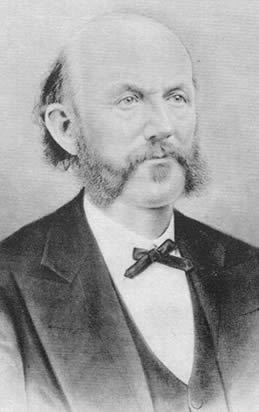
Elisha Bliss
(b. 1822 - d. 1880)
Mark Twain's publisher gained rights to many of his early works |
Mark Twain's first major work The Innocents Abroad was published
in 1869 by American Publishing Company of Hartford, Connecticut. The
company was a relatively new business, founded in 1865 and specializing
in subscription book publishing. Subscription books were sold by door-to-door
salespersons who took advance orders, mostly from residents in rural
areas of the country.
American Publishing Company was headed by Elisha Bliss and his sons
Frank and Walter. Under the Bliss management, the company published
other Mark Twain titles including Roughing It (1872); The
Gilded Age (1873), a novel written in conjunction with Twain's neighbor
Charles Dudley Warner; Sketches New and Old (1875), a collection
of Mark Twain's early newspaper and magazine contributions; The Adventures
of Tom Sawyer (1875); and A Tramp Abroad (1880).
Twain's first editions were elaborately and profusely illustrated.
Buyers could choose from a variety of bindings with gilt stamping, all
of which were intended to provide visual appeal. Clemens eventually
became a director and partner in American Publishing Company but grew
increasingly distrustful of Elisha Bliss and his bookkeeping shenanigans.
|
|
After publication of A Tramp Abroad with American Publishing
Company, Clemens switched publishers and teamed up with James Ripley
Osgood who had published Bret Harte's first book. Osgood was affiliated
with Atlantic Monthly, the magazine that had published Mark Twain's
"A True Story" in 1874. Osgood later issued it as the title
story in a small book titled A True Story and The Recent Carnival
of Crime (1877). Osgood published Mark Twain's The Prince and
the Pauper in 1881 and The Stolen White Elephant in 1882
-- the same year Houghton, Mifflin and Company released Bret Harte's
uniform edition.
In early 1882 Osgood and Clemens returned to the Mississippi River
valley to gather stories and ideas for his next book, Life on the
Mississippi. In late October 1882 Osgood brought Clemens's nephew
by marriage Charles L. Webster into his company to help manage a subscription
book department. Osgood published Life on the Mississippi in
May 1883. Sales of Life on the Mississippi were disappointing
and Clemens decided to drop Osgood as his publisher and start his own
publishing firm called Charles L. Webster and Company in 1884.
Osgood's firm went bankrupt in 1885 and he found work with Harper and
Brothers as their agent in London.
|
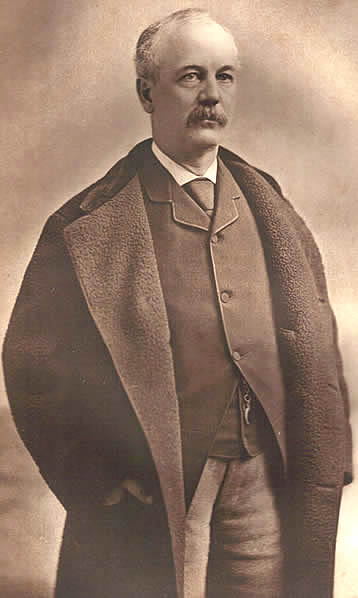
James Ripley
Osgood (b. 1836 - d. 1892) |
Mark Twain, Webster and Company and A Library of American Literature
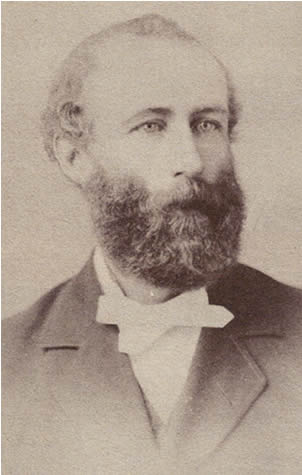
Charles
Luther Webster (b. 1851 - d. 1891) was Samuel Clemens's nephew by marriage |
When Clemens started his own publishing house in May 1884, he hired
his nephew Charles Webster to manage it and gave the company Webster's
name. The first book issued by Webster and Company was Mark Twain's
Adventures of Huckleberry Finn in 1885. In 1889 Webster and Company
published their second Mark Twain book -- A Connecticut Yankee in
King Arthur's Court.
In addition to his own works, the company published works of other
authors, including the memoirs of Ulysses Grant, one of the company's
most successful endeavors. When Clemens's former publisher James R.
Osgood went bankrupt in 1885, Webster and Company took over the rights
to the Mark Twain titles that had been published by Osgood. Webster
reissued editions of The Prince and the Pauper (1885, 1887, 1889,
and 1891), The Stolen White Elephant (1888), and Life on the
Mississippi (1888 and 1891). (For a complete listing of other Webster
and Company's titles, see "Mark
Twain, Publisher").
|
Between 1887 and 1890 Webster and Company embarked on a project
to sell by subscription a uniform edition of A Library of American Literature:
From the Earliest Settlement to the Present Time, an elaborate eleven-volume
edition of various American authors. The volumes were edited by Edmund Clarence
Stedman and Ellen MacKay Hutchinson. Stedman was a journalist, poet and member
of the New York Stock Exchange. Hutchinson, who later married art critic Royal
Cortissoz, was on the editorial staff of the New York Tribune. The
eleven-volume set included leather bindings, marbled end boards, and tissue
guards for steel engravings. Every noted American author was represented.
Mark Twain's contributions were included in Volume 9 and consisted of three
selections -- "The Notorious Jumping Frog of Calaveras County,"
a passage from The Prince and the Pauper, and a passage from Adventures
of Huckleberry Finn.
Webster and Company enlisted endorsements for the edition from
such noted authors as John Greenleaf Whittier, William Dean Howells and Thomas
Wentworth Higginson. In the sales prospectus for the edition Mark Twain is
quoted saying: "'The Library of American Literature' is monumental....
With it on the shelf, one may say to anybody --'Name your mood, and I will
satisfy its appetite for you.'" Subscribers for the edition included
prominent public figures. The set was published with a copyright date of 1891.
However, with subscription publishing, payment for the books was not always
received up front when it was most needed. This expensive project would eventually
be a major factor in the failure of Webster and Company. Clemens later recalled
the project in memoirs that were published in Mark Twain in Eruption:
Stedman, the poet, made a compilation, several years earlier, called
The Library of American Literature -- nine or ten octavo volumes.
A publisher in Cincinnati had tried to make it succeed. It swallowed
up that publisher, family and all. If Stedman had offered me the book
I should have said "Sold by subscription and on the installment
plan, there is nothing in this book for us at a royalty above four per
cent, but in fact it would swamp us at any kind of royalty, because
such a book would require a cash capital of several hundred thousand
dollars, and we haven't a hundred thousand."
But Stedman didn't bring the book to me. He took it to Webster. Webster
was delighted and flattered. He accepted the book on an eight per cent
royalty, and thereby secured the lingereing suicide of Charles L. Webster
and Company.
The slow cash flow from subscription books sales, especially
the expensive-to-produce uniform edition of Library of American Literature,
combined with Clemens's other unsuccessful investments, forced Clemens to
find ways to reduce his family's living expenses. In the summer of 1891 he
closed his mansion in Hartford and moved to Europe. Clemens became a trans-Atlantic
commuter to handle his publishing business.
Uniform Ideas: 1891-1893
The idea of issuing his own collected works in a uniform edition
continually appealed to Clemens as a means of increasing his royalties. According
to Mark Twain scholar Louis Budd, Clemens "wanted the psychological reassurance
and the visible, substantial badge of a collected edition" (Budd, p.
93).
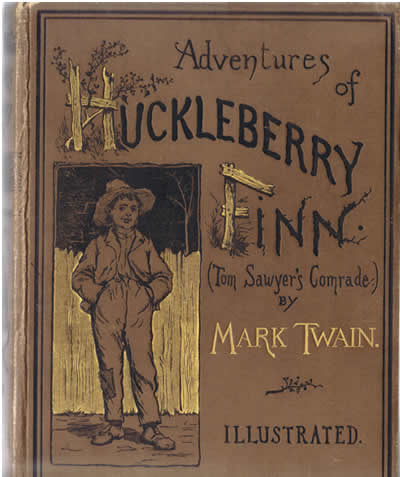 An 1891
Holiday Edition in light brown cloth was the first attempt by Clemens
to publish three of his own works in a uniform edition sold as a set.
An 1891
Holiday Edition in light brown cloth was the first attempt by Clemens
to publish three of his own works in a uniform edition sold as a set.
Photo courtesy of Kevin Mac Donnell. |
An item in Literary News, December 1891, p. 368 announced:
Holiday Edition of Mark Twain. -- The three best books of America's
celebrated humorist are acknowledged to be "The Prince and the
Pauper," "The Adventures of Huckleberry Finn" and "A
Connecticut Yankee at King Arthur's Court." ... These books are
uniformly bound in a handsome shade of light brown cloth and are put
up in a pretty white-and-gold box. ... No more acceptable present can
be selected for busy, tired business men than a set of Mark Twain. This
edition is sold only in sets; but the separate volumes can be had in
the old style or in a set at $2.75. (Webster, $8.75.)
|
Other advertising priced the three-book set at $6.00, complete in a box or
individually priced from $2.75 - $3.00 each. The books were square octavo and
uniform in style. According to rare book collector Kevin Mac Donnell, the Holiday
Edition of 1891 was printed from the plates of the first editions with no changes
to texts other than the title-page date. All were bound in light brown cloth
with new spine designs, but the cover designs were stamped from the same brasses
as the first edition bindings. According to Mac Donnell, "So far as I can
determine, all three were the last editions printed from the first edition plates
for these three titles."
In 1891 Webster also released smaller, inexpensive editions of Adventures
of Huckleberry Finn and The Prince and the Pauper in matching bindings.
Known in the book trade today as the "cheap" editions, these editions
sold for $1 and were bound in matching light tan bindings to appeal to buyers
on a more limited budget who also wanted uniformity. These editions were from
new printing plates and used fewer illustrations than previous editions. These
volumes were "12mo" (duodecimo).
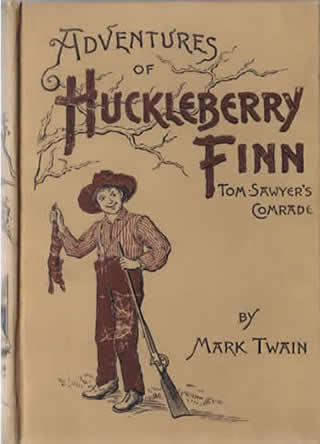 xxx
xxx
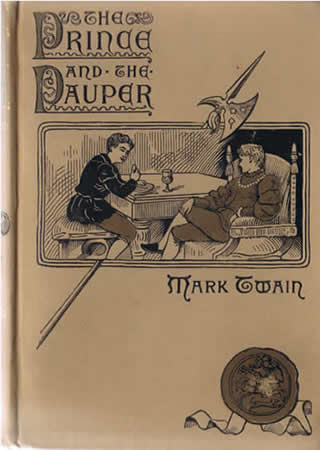
Photos of "cheap"
editions first issued in 1891 by Webster and Company courtesy of Kevin Mac Donnell.
For a complete comparison of the illustrations that were selected
for use in the 1891 edition of Huckleberry Finn, see "1891
Huck Finn Illustrations" online from the University of Virginia.
Webster's marketing attempts with the cheap editions of titles
from his own stock were matched in kind by the American Publishing Company who
retained the rights to The Adventures of Tom Sawyer and Sketches New
and Old. The 1892 and 1893 editions of these two books from American Publishing
Company and Watson Gill also featured tan bindings.
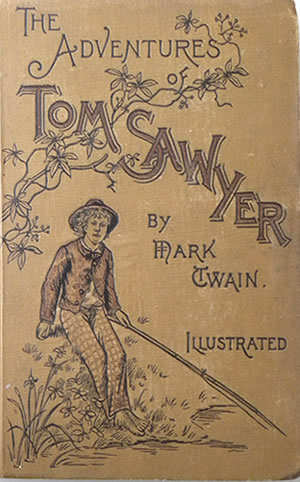
1892 edition
issued by Watson Gill and American Publishing Company |
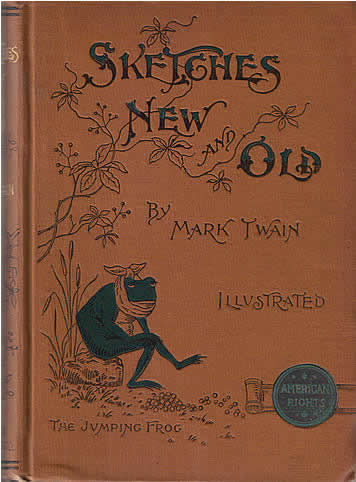
1893 edition
issued by Watson Gill and American Publishing Company
utilized new printing plates, reduced the number of stories from 63 to 48
and eliminated many of the original illustrations. |
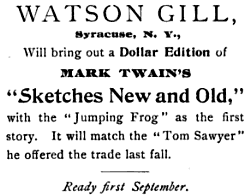
Ad from
Publisher's Weekly, September 9, 1893
|
Watson Gill (b. 1837- d. 1903) of Syracuse, New York was a prominent
bookseller and affiliate of American Publishing Company. In his latter
years he worked in the wholesale book trade and according to his obituary
had amassed a considerable fortune at the time of his death. Gill later
obtained from Webster and Co. the exclusive rights to publish Mark Twain's
Life on the Mississippi. Clemens described Gill as "an excellent
man to handle books, and is prompt pay..." (Clemens letter to Henry
H. Rogers, 9 December 1894.) It is likely that Gill's attempts to match
the style and bindings of Webster's inexpensive additions were met with
favor by Clemens.
|
Webster did not attempt further efforts to make Mark Twain's works look "uniform."
The company issued Mark Twain's Merry Tales and The American Claimant
in 1892 in their own separate and unique bindings. These two books were followed
by The £1,000,000 Bank-Note and Other New Stories (1893) and
Tom Sawyer Abroad (issued on 18 April 1894, the same day Webster and
Company filed for bankruptcy). Faced with a monumental task of pulling himself
up from financial failure, Clemens who was living abroad continued to write
and returned once again to Frank Bliss and the American Publishing Company
for the release of his next book, The Tragedy of Pudd'nhead Wilson,
in November 1894. Clemens felt the publication of a complete uniform edition
of his works would translate into additional royalties, money he badly needed.
But his copyrights were scattered. What he needed was a sound financial advisor
and contract negotiator. Enter Henry Huttleston Rogers.
_____
_____
References
Budd,
Louis J. "Mark Twain's Books Do Furnish a Room: But a Uniform Edition
Does Still Better," Nineteenth Century Prose, Vol. 25, No. 2,
Fall 1998, pp. 91-102.
Leary,
Lewis, ed. Mark Twain's Correspondence with Henry Huttleston Rogers 1893-1909.
(University of California Press, 1969).
LeMaster,
J. R. and James D. Wilson, eds. The Mark Twain Encyclopedia. (Garland
Publishing Inc., 1993).
Mac
Donnell, Kevin. Personal correspondence, September 2009.
Mark
Twain Project online database of letters from the Mark Twain Papers/Project
at the University of California at Berkeley.
Rasmussen,
R. Kent. Critical
Companion to Mark Twain, Volumes I and II. (Facts on File, 2007).
Twain,
Mark. Adventures of Huckleberry Finn. The Works of Mark Twain edition.
Victor Fischer and Lin Salamo, eds. (University of California Press, 2003).
_____.
Mark Twain in Eruption. Edited and with an introduction by Bernard
DeVoto. (Harper and Brothers, 1940).
Waters,
Henry Fitz-Gilbert. The New England Historical and Genealogical Register,
Vol. 58. (New England Historic Genealogical Society, 1904). Online from google
books - (contains memoir of Watson
Gill by Ezekiel W. Mundy, pp. cviii - cix).







 xxx
xxx




